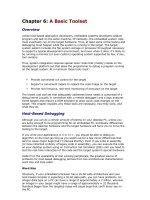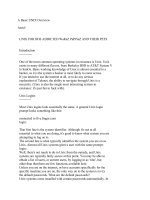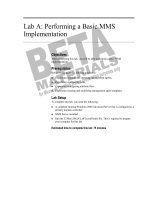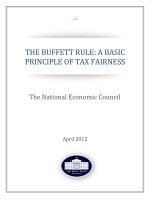A Basic MIMAP Poverty Profile
Bạn đang xem bản rút gọn của tài liệu. Xem và tải ngay bản đầy đủ của tài liệu tại đây (50.22 KB, 9 trang )
<span class='text_page_counter'>(1)</span>A basic MIMAP poverty profile Louis-Marie Asselin, CECI, 10/04/00. At the last MIMAP international workshop in Kathmandu, Nov. 1998, the PMS group, under the coordination of Celia Reyes, decided that an effort should be done to collect from every MIMAP team the list of poverty indicators they were considering in their PMS research and to identify a common subset of indicators from these lists. Mustapha Mujeri was given a mandate on this, and the result came out in Spring 1999 under the form of a short list of « Proposed MIMAP Indicators », given in Appendix. During our last September MIMAP training session on poverty measurement and analysis, the idea came out that there should be a kind of standard basic poverty profile to be presented by all national MIMAP teams at the MIMAP international workshop in Manila, next September. Recently, in his MIMAP update message, Randy Spence announced that I would soon be in touch with all of you on this issue. After some consultation within the MIMAP network, here is the format that is proposed for this basic poverty profile. Objectives All MIMAP teams do some research on poverty measurement and analysis, as a contribution to a poverty monitoring system methodology which would be appropriate to design relevant and efficient poverty reduction policies and to assess the impact of such policy. An expected output of such work, even if not the only one, should be a regularly updated national poverty profile reflecting the MIMAP philosophy of a multidimensional concept of poverty, operationalized in measurement and analysis according to a transparent and participative approach. A first objective of a Basic MIMAP Poverty Profile (BMPP) should be to explicit the MIMAP personality in its approach to poverty. A second objective should be to contribute to the necessary network focus needed if we want that the whole MIMAP research work has a real impact on poverty alleviation policies implemented in the MIMAP countries. A third objective would be to share in a more efficient way the methodologies developed through the whole network, so that new MIMAP national teams can benefit quickly from more advanced teams expertise in the area of improving poverty profiles quality and relevance for policy design and assessment. The MIMAP training program, in particular, would then become itself a more efficient tool in capacity building. To meet all these objectives, a common information basis is needed, the BMPP, on which basis every national team can obviously develop a more extended poverty information system to meet the specific countries needs and capacity to integrate advanced analysis tools. Thus, the BMPP should be perceived as an information tool with the following characteristics : simplicity, reliability, and policy relevance. Simple : it must refer to indicators which can be as less controversial as possible and understood by a large group of persons involved in poverty reduction strategies. Reliable : the quality of information must be regularly assessed and continuously improved by methodological work; it should had gone through the process of public discussion and official publication as much as possible. Policy relevant : it must refer to poverty dimensions and present figures needed as well for policy targeting as for policy assessment through space and 1.
<span class='text_page_counter'>(2)</span> time. No data source should be excluded, once the quality assessment is done. We can then conceive that the BMPP makes use of different data sources : censuses, surveys and administrative data. Structure of the Basic MIMAP Poverty Profile. Even if we try here to describe a common structure for the BMPP, it must be understood that there is room for flexibility, first to recognize that a same poverty dimension does not materialize in the same way in each country, second to present, in each country, information that really talks to the policy makers. Nevertheless, it is possible to respect a basic structure in each country. A consensus on what should appear in a poverty profile is always difficult to reach in a given country, what to say for thirteen countries! Thus, we will rely largely on the result reached precedently with the list of indicators given in Appendix I (referred to as « List I »). For areas and indicators the approach will be to take as much as possible from List I, and not to add anything more. But we added three indicators which seem clearly implicit in the List I, two of them being presented as substitutes. We interpret List I as what the different MIMAP teams would like to develop as common indicators, not necessarily as what they identify as being generally available now at national level. Our criterion for not retaining all of List I is to try to keep what we frequently see in published poverty profiles and can be expected as available at national level, with some variants from one country to another. Thus, the approach is a minimalist one. Poverty dimensions: areas. As recognized generally and particularly within the MIMAP network, poverty is a multidimensionnal concept. This is clearly demonstrated in List I, with 12 areas. Without necessarily classifying the indicators in exactlly the same areas (see the next section), we propose to retain the nine (9) following areas : • • • • • • • • •. Income/expenditure Employment Nutrition Education Health Water/Sanitation Housing Assets Services. In spite of their importance, it appears that List I areas #8 (credit), #10 (access to organisations) and #11 (crisis and crisis coping) are not really available, usually, at national level. For this reason, they certainly deserve an important attention in MIMAP PMS research. Indicators. 2.
<span class='text_page_counter'>(3)</span> •. Income/expenditure 1. I/E per capita. It is one of the three indicators we add to list I. According to data available, it could be substituted by any other reliable I/E variable. We suggest to take : real annual expenditure per capita. This is the most common money-metric indicator. 2. Money-metric poverty indexes : - 2.1 head count - 2.2 poverty gap - 2.3 squared poverty gap 3. Gini coefficient I/E 4. Household expenditure pattern Distribution of expenditure (%) according to food/non-food, and eventually nonfood component broken down (country specific). 5. Sources of household income Sources of income are country specific. Usual categories include : farm, non-farm enterprises, wages. Average real household income, by income source.. •. Employment We should understand that this area is a particularly difficult one. Definitions of employment, unemployment, underemployment, sectors, etc., are country specific. 1. Sectoral distribution of employment by sex. Usual sectors are : agriculture, industry, services. 2. Unemployment by sex (mostly significant in urban area) 3. Underemployment by sex (mostly significant in rural area) 4. Average agricultural/non agricultural wage by sex. 5. Dependency ratio.. •. Nutrition 1. Calorie intake per capita, per day. •. Education 1. Adult literacy rates by sex 2. Primary school enrolment rates by sex Age-group is country specific. 3. Primary school drop out rates by sex 4. Access to primary school Country specific definition. Not in list I. More relevant in rural areas : e.g., percentage of population with a primary school in the village. Could even be : percentage of villages with a primary school. Health 1. Life expectancy at birth by sex 2. Infant mortality rate by sex 3. Child mortality rate by sex 4. Access to primary health center. •. 3.
<span class='text_page_counter'>(4)</span> •. •. Country specific definition. Not in list I. More relevant in rural areas : e.g., percentage of population with a primary health center in the village. Could even be : percentage of villages with a primary health center. Water/Sanitation 1. Access to potable water. 2. Sanitation Both indicators need country specific definitions. Housing 1. Roofing material of main house 2. Wall material of main house 3. Number of persons per room #1 and #2 are country specific.. •. Assets 1. Land distribution by size class Size classes are country specific. 2. Land distribution by tenancy type Tenancy type is country specific 3. Ownership of agricultural productive assets 4. Ownership of non-agricultural productive assets For # 3 and #4, assets definition is country specific 5. Percentage of landless households Except #4, all other indicators are relevant in rural area only.. •. Services 1. Access to electricity Country specific definition. As can be seen, List I #9 area (public expenditure) is compensated by the introduction of two accessibility indicators in areas « Education » and « Health ». Socioeconomic classifications Whatever be the list of areas and indicators finally retained, the poverty profile will not be really useful for poverty reduction strategy if it is not disaggregated according to some socioeconomic classifications which reveal inequity in the society. Here again, it’s always a very long discussion to generate a consensus on which classifications should be use. Fortunately, in some sense, data constraints and feasibility realism reduce considerably the list of operational classifications. We first propose two classifications which are standard in the literature : 1. Rural/Urban areas. 2. Regions. Definitions are obviously country specific. The regions always have an administrative definition, but usually correspond to agro-ecologic diversity. These both classifications present the advantage of being used almost systematically in any serious statistical work in the country.. 4.
<span class='text_page_counter'>(5)</span> To these first two classifications, we had a third one which is fact present in List I where area #12 refers to the characteristics of female headed households. The MIMAP approach promotes strongly a gender view on poverty. In addition to the disaggregation of all relevant indicators according to sex (see above), the gender focus can be operationalized with the following third socioeconomic classification : 3. Household type Here « type » must be understood as including necessarily the two categories female/male headed households. According to country, e.g. where polygamy is officially allowed, these basic categories can be disaggregated in finer sub-categories. Thus, if we conceive that there is a statistical table for each of the nine areas enumerated above, each indicator in each table should be disaggregated according to these three socioeconomic classifications, unless for a specific indicator it seems obviously irrelevant, in which case the mention « n.a » (not applicable) should appear. In view of uniformization and to facilitate inter-country comparisons, we suggest that in each table, indicators are presented in rows, and socioeconomic classifications in columns. Also, rual/urban and region could be integrated in the same table, a second table being built for household type.. Time change dimension Poverty change is obviously a major information to assess the impact of poverty reduction policies. With the tremendous statistical efforts done in developing countries since one or two decades, it is not unusual that we now find at least two points in time with comparable poverty indicators measurement. We suggest that the BMPP integrate in each table (area) a time interval with two corresponding values for each indicator figure. The time interval could be something like a five-year one. It is again not only country specific, but also table specific, according to data availability constraints. Accuracy information Indicators can be generated from censuses, administrative data, or surveys. This last case is a frequent one. National surveys are generally probabilist. In that case, an accuracy statement is possible for each estimated parameter. When the data source is a probabilist survey, we propose to use the usual way of presenting the results by accompanying each parameter figure with its 95% confidence interval. It allows the poverty profile user to qualify the significance of observed difference between socioeconomic groups or across time. Tables format and numbering With the nine areas proposed above, we got nine tables, to which a tenth one is absolutely required, as the first one : a demographic table giving the population distribution across the three socioeconomic classifications used in all nine subsequent poverty indicators tables. These information are needed to get interpret correctly and get absolute figures from the distributions presented in subsequent tables. In all MIMAP profiles, we. 5.
<span class='text_page_counter'>(6)</span> suggest to use the same numbering system, so that when doing comparisons between countries or across time, we always refer to the same tables without any confusion. The BMPP has then the following ten tables : Table 1 Demography 1A Household distribution, absolute numbers and percentages, by rural/urban and region, years x and y. 1B Household distribution, absolute numbers and percentages, by household type, years x and y. Table 2 Income/expenditure 1A Indicators 2.1 to 2.5, by rural/urban and region, years x and y. 1B Indicators 2.1 to 2.5, by household type, years x and y. Table 3 Employment 1A Indicators 3.1 to 3.5, by rural/urban and region, years x and y. 1B Indicators 3.1 to 3.5, by household type, years x and y. Table 4 Nutrition 1A Indicator 4.1, by rural/urban and region, years x and y. 1B Indicator 4.1, by household type, years x and y. Table 5 Education 1A Indicators 5.1 to 5.4, by rural/urban and region, years x and y. 1B Indicators 5.1 to 5.4, by household type, years x and y. Table 6 Health 1A Indicators 6.1 to 6.4, by rural/urban and region, years x and y. 1B Indicators 6.1 to 6.4, by household type, years x and y. Table 7 Water/Sanitation 1A Indicators 7.1 to 7.2, by rural/urban and region, years x and y. 1B Indicators 7.1 to 7.2, by household type, years x and y. Table 8 Housing 1A Indicators 8.1 to 8.3, by rural/urban and region, years x and y. 1B Indicators 8.1 to 8.3, by household type, years x and y. Table 9 Assets 1A Indicators 9.1 to 9.5, by rural/urban and region, years x and y. 1B Indicators 9.1 to 9.5, by household type, years x and y. Table 10 Services 1A Indicator 10.1, by rural/urban and region, years x and y. 1B Indicator 10.1, by household type, years x and y. As said before, we recommend that indicators be in lines, and socioeconomic classifications in columns. We also recommend that years be in columns, and confidence intervals, for survey estimates, be in the line immediately below the estimate (± value). For each table, the different sources of data are given in footnotes.. 6.
<span class='text_page_counter'>(7)</span> Standard table of contents A standard table of contents would be like this : Introduction General presentation of the profile. Demography Table 1 Comments A description of the socioeconomic classifications, using eventually auxiliary tables country specific (with a different numbering sequence). Income/Expenditure Table 2 Comments When commenting any area table, use should be made of any participative poverty assessment (perceptions), when available. Employment . . . Services Conclusion The main observed facts, with a link with policies implemented in the relevant period. Technical appendix Technical notes relative to each of the ten tables : definitions, data sources methodologies, etc. References Conclusion We have presented here a proposal for a standard Basic MIMAP Poverty Profile (BMPP). It builds essentially on the last year concerted effort to identify a list of MIMAP indicators (see Appendix). From now to the September meeting, there is no time to generate new data, just enough time to gather in a specific format data which each national MIMAP team is supposed to be familiar with. Any comment during this exercise will be well received. In September, we will take the opportunity to discuss the relevance of this poverty profile structure and to bring the required adjusments.. 7.
<span class='text_page_counter'>(8)</span> Appendix. Proposed MIMAP Indicators Area. I n d I c a t o r (s). 1. Poverty measure(s). •. Head count, poverty gap, squared poverty gap. 2. Income/Expenditure/Nutr ition. • • • •. Gini coefficient income/expenditure Sources of household income Household expenditure pattern Calorie intake per capita per day. 3. Occupation/Employment. • • • •. Dependency ratio Sectoral distribution of employment by sex Employment and un/under employment status by sex Average agricultural/non agricultural wage rate by sex. to •. 4. Access resources/services. • •. Land distribution by size class/tenancy and share of landless households Ownership of agricultural/non-agricultural productive assets Access to potable water, sanitation, electricity. 5. Housing. •. Roofing/wall materials of main house and number of persons per room. 6. Education. • •. Adult literacy rate by sex Primary school enrolment/drop out rates by sex. 7. Health. • •. Life expectancy at birth by sex Infant/child mortality rate by sex. 8. Credit. •. Extent of indebtedness and access to institutional/non institutional credit. 9. Public expenditure. •. Percent of total public expenditure (and/or GDP) to primary education, primary health care and other human development sectors. to •. Percent with membership in formal/informal organisations by type and sex. crisis • •. Percent of households facing crisis by type and crisis coping measures adopted In- and out- migration rates. •. Percent of female headed households and characteristics. 10. Access organisations 11. Crisis coping. 12. Other. and. 8.
<span class='text_page_counter'>(9)</span> 9.
<span class='text_page_counter'>(10)</span>









